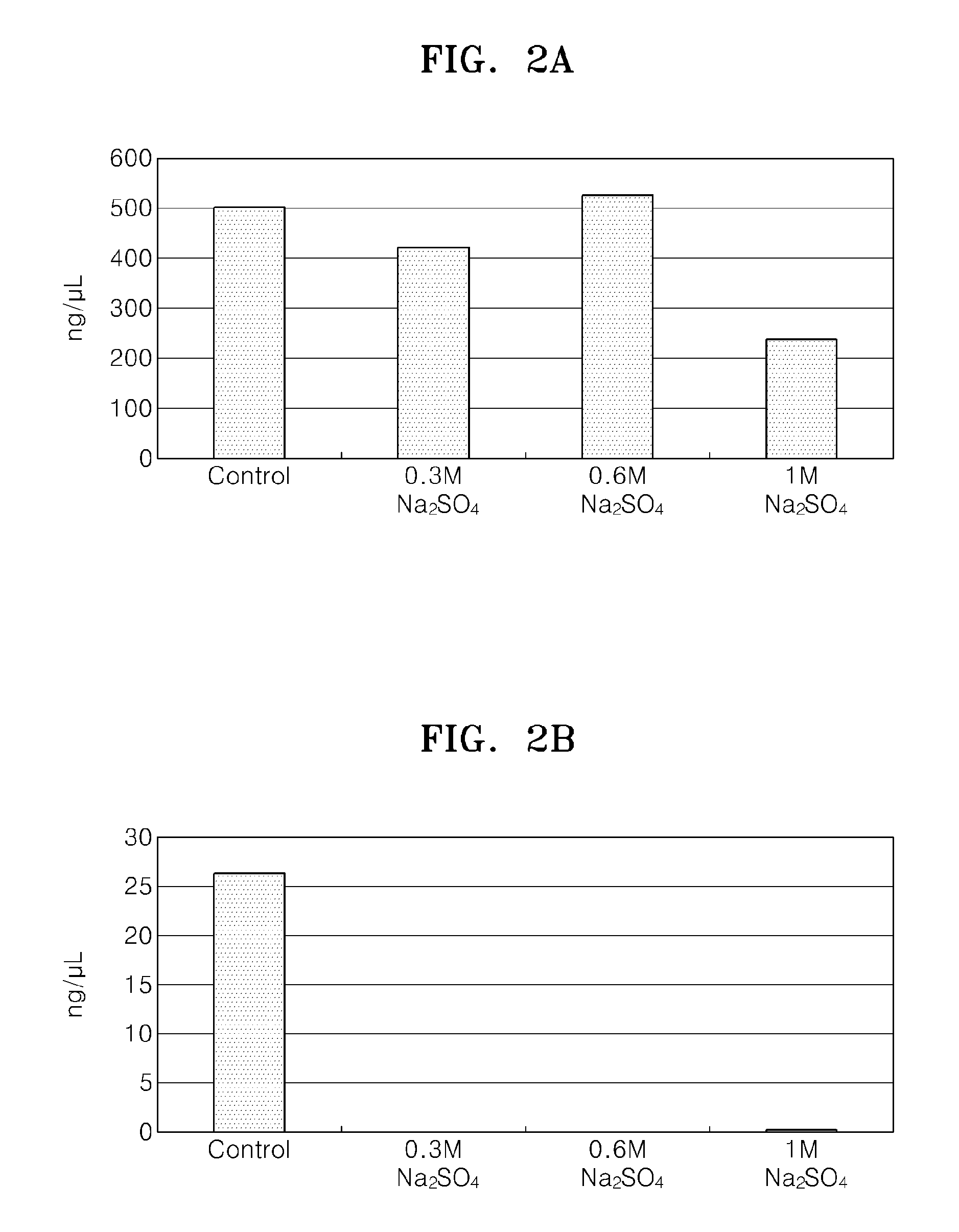Method of purifying RNA using kosmotropic salt
a technology of kosmotropic salt and rna, which is applied in the field of purifying rna using kosmotropic salt, can solve the problem of large amounts of dna contaminants in the rna obtained
- Summary
- Abstract
- Description
- Claims
- Application Information
AI Technical Summary
Benefits of technology
Problems solved by technology
Method used
Image
Examples
example 1
Yield of RNA Purification Using a Kosmotropic Acetate
[0056]According to the provided protocol from Qiagen™ kit (RNeasy™ Protect Bacteria Mini Kit), E. coli was treated with lysozyme and proteinase K to produce a E-coli lysate.
[0057]200 μl of the E. coli lysate (1×108˜7.5×108 E. coli cells lysed) and 1 mL sodium acetate (NaOAc) were mixed by vigorous vortexing, such that the mixed solution had a sodium acetate concentration of 0.1M (based on NaOAc), 0.3M, 0.6M, 1M, or 3M, and its pH is adjusted to 4 by adding glacial acetic acid. 600 μl of the mixed solution was placed in a Qiagen™ kit column (Qiagen RNeaSy™ Mini spin column, silica gel membrane column) and centrifuged at 8000 g for 15 seconds. After washing the column with 700 μl of 1 mM NaOAc containing 3 mM of NaCl, and 500 μl of 25 mM Tris buffer (pH 7) including 80% ethanol twice, the column was centrifuged for 2 minutes at 8000 g. After transferring the column to a new 1.5 mL Eppendorf tube, 50 μl of DEPC (diethylpyrocarbonate)...
example 2
Yield of RNA Purification Using a Kosmotropic Sulfate
[0060]An experiment was performed in the same manner as Example 1, except that 0.3M Na2SO4, 0.6M Na2SO4, 1M Na2SO4, 0.3M (NH4)2SO4, 0.6M (NH4)2SO4, and 1M (NH4)2SO4 were used instead of the acetate salt. The above salts were dissolved in 0.1M sodium acetate buffer, pH 4.0, to produce a binding solution.
[0061]FIG. 2A and FIG. 2B shows RNA yields and the levels of DNA contamination, respectively, when Na2SO4 was used as a kosmotropic salt according to Example 2.
[0062]FIG. 3A and FIG. 3B shows RNA yields and the levels of DNA contamination, respectively, when (NH4)2SO4 was used as a kosmotropic salt according to Example 2.
[0063]Table 2 below shows a weight percentage of the amount of gDNA with respect to the total amount of the obtained RNA when Na2SO4 was used, and Table 3 shows weight percentages of the amount of gDNA with respect to the total amount of the obtained RNA when (NH4)2SO4 was used as a kosmotropic salt.
TABLE 2Control G...
example 3
Yield of RNA Purification Using K Kosmotropic Chloride
[0064]An experiment was performed in the same manner as Example 1, except that 0.3M NaCl, 0.6M NaCl, 1M NaCl, and 2.5M NaCl were used in place of the acetate salt, in order to provide a kosmotropic salt chloride.
[0065]FIG. 4A and FIG. 4B shows RNA yields and the levels of DNA contamination respectively, of the purified RNA according to Example 3 when NaCl was used as a kosmotropic salt.
[0066]Table 4 below shows weight percentages of the amount of gDNA with respect to the total amount of the obtained RNA.
TABLE 4Control Group0.3M NaCl0.6M NaCl1 M NaCl2.5M NaCl4.050%0.07%0.005%2.292%0.942%
[0067]FIG. 5A is a graph showing the RNA yield data obtained in Examples 2-3, each using a kosmotropic acetate, sulfate, and chloride salt, respectively, and FIG. 5B is a graph showing the levels of DNA contamination in the purified RNAs, obtained in Examples 2-3.
[0068]Generally, it can be seen that at a concentration ranging 0.3M-1M of the kosmotr...
PUM
| Property | Measurement | Unit |
|---|---|---|
| Molar density | aaaaa | aaaaa |
| Molar density | aaaaa | aaaaa |
| Acidity | aaaaa | aaaaa |
Abstract
Description
Claims
Application Information
 Login to View More
Login to View More - R&D
- Intellectual Property
- Life Sciences
- Materials
- Tech Scout
- Unparalleled Data Quality
- Higher Quality Content
- 60% Fewer Hallucinations
Browse by: Latest US Patents, China's latest patents, Technical Efficacy Thesaurus, Application Domain, Technology Topic, Popular Technical Reports.
© 2025 PatSnap. All rights reserved.Legal|Privacy policy|Modern Slavery Act Transparency Statement|Sitemap|About US| Contact US: help@patsnap.com



